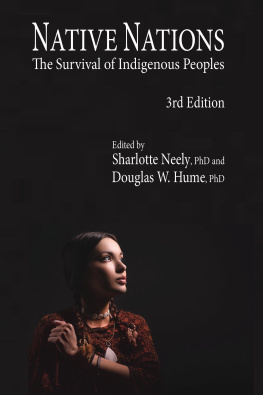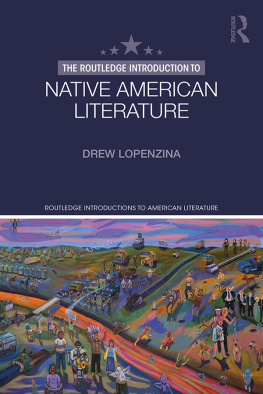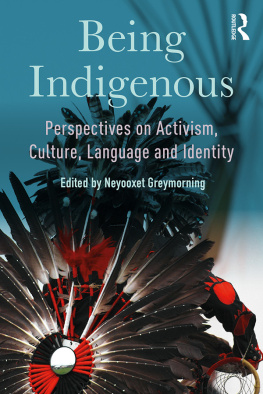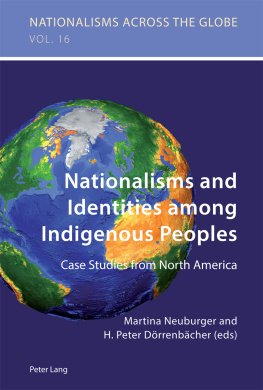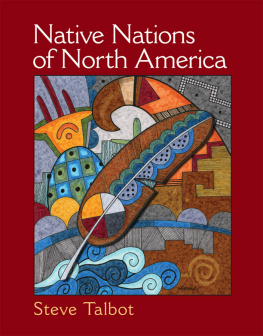
JCharlton Publishing Ltd.
3104 30th Ave., Suite 228
Vernon, BC, V1T-9M9
Canada
315 S. Whitcomb Ave. #101
Tonasket, WA 98855
United States
www.jcharltonpublishing.com
Copyright 2020 JCharlton Publishing Ltd. All rights reserved. No part of this publication may be photocopied, reproduced, stored in a retrieval system, or transmitted, in any form or by any means, electronic, mechanical or otherwise, without the written permission of JCharlton Publishing Ltd., except for brief passages quoted for review purposes.

Map of the Fourth World Sharlotte Neely.
Author photo (Neely), back cover, Katie Englert.
Author photo (Hume), back cover, Douglas W. Hume.
Library and Archives Canada Cataloguing in Publication
Title: Native nations : the survival of indigenous peoples / edited by Sharlotte Neely, PhD, Douglas W. Hume, PhD.
Other titles: Native nations (Vernon, B.C.)
Names: Neely, Sharlotte, 1948- editor. | Hume, Douglas W., editor.
Description: 3rd edition. | Includes bibliographical references and index.
Identifiers: Canadiana (print) 20200174266 | Canadiana (ebook) 20200174290 | ISBN 9781926476292 (softcover) | ISBN 9781926476315 (EPUB) | ISBN 9781926476346 (Kindle)
Subjects: LCSH: Indigenous peoples. | LCSH: Indigenous peoplesSocial conditions.
Classification: LCC GN380 .N38 2020 | DDC 305.8dc23
This book is dedicated to our former, current, and future students.

PART I
Introduction
What It Means to Be Indigenous
Sharlotte Neely
Northern Kentucky University
T he World Bank estimates that there are more than 300 million Indigenous People on the planet, or about 5% of the worlds population. They have survived repeated invasions and conquests by both non-Western and Western groups. These threats to their very survival are not just the stuff of history, as with the Cherokee Removal of 1838-39. In 2019 the government of India began actions to remove 8 million Adivasi (the term for Indias Indigenous Peoples) from the forestlands on which they have lived for millennia. Ironically, this move was done in the name of conservation, despite removing people with a negligible impact on the environment and replacing them with high impact corporations.
Despite acculturating to some degree, Native groups throughout the world have survived with their unique ethnic identities and many of their cultural traditions intact. Some of these Indigenous Peoples long someday to make the transition from the world's unrecognized, non-sovereign, "wannabe nations" like Tibet, Kurdistan, Catalonia, Euskal Herria, and the Kingdom of Hawaii into sovereign nations as South Sudan has recently done for the Nuer and Dinka. Other Indigenous Peoples would settle for a measure of autonomy within their existing nations. In this edition of Native Nations, a group of anthropologists (and the occasional linguist, historian, geographer, and political scientist) focus on a diverse group of Indigenous Peoples across the planet. All are compared in regard to their strategies for survival.
This books group of Indigenous Peoples, while representative, is not exhaustive and could, for example, also include additional groups within First World nations like the Ryukyuans of Okinawa (Japan), Torres Strait Islanders of Australia, the Chamorros of Guam (the USA), Samaritans of Israel, and the Scots and Welsh in the United Kingdom and within Second and Third World nations the Ainu, Sami, and Tungus of Russia; Mosuo of China; Semang of Malaysia; Andaman Islanders of India; Baka of central Africa; Hadza of Tanzania; and various Native American groups throughout Latin America.
Studies of Indigenous Peoples were especially encouraged by the illustrious anthropologist Fredrik Barth (1969) in his classic book, Ethnic Groups and Boundaries, when he noted that not all ethnic groups succumb to acculturation and disappearance despite intense pressure to do so. As with many of my other publications, in many ways this book is an homage to Barth. I am also inspired by the work of the Native American and Indigenous Studies Association (NAISA).
The Indigenous Peoples considered here are diverse. At contact some, like the Aborigines of Australia, were nomadic foragers; others, like the Sami and Basques survived on domesticated animals or plants; and others, like Native Hawaiians and the Bretons, lived within complex chiefdoms that soon developed into sovereign states. Various individual Native North American groups fall into all three of those categories. Of the Indigenous Peoples considered here, many were the only peoples in their territories for thousands, and often tens of thousands, of years, before later peoples invaded their lands. Today most Indigenous Peoples comprise less than 5%--sometimes much less than 5%--of their particular nations population. One of the major exceptions is the Maori of New Zealand who are more than 15% of their nations population and increasing in number and percentage. Of the examples examined here, some, such as the Ainu of Japan, live in a country without a European heritage. The Natives of Taiwan are an example of a group dominated by both Asian (China and Japan) and European (the Netherlands and Spain) nations. The San are an example of a group dominated by both African (the Bantu) and European (Dutch and English) sources.
All the Indigenous groups here have concerns about preserving their traditional values, languages, sacred lands, festivals, art, music, foods, clothing styles, and other aspects of their culture. All went through periods where their nations attempted to assimilate them, often by forcing their children to be educated at boarding schools far from home and by suppressing their native languages. Many encompass a great deal of linguistic and other diversity. For example, there are nine surviving Sami languages, more than two dozen Native Taiwanese languages, hundreds of Australian Aboriginal languages, and hundreds of Native American languages. There are more than one hundred Maori groups. Some, like the Ainu, Basques, Bretons, and Punjabis have even had their claims of being Indigenous challenged. All minimally desire some degree of sovereignty within their modern nations. Here at the beginning of the 21st century, all have achieved some level of appreciation within their nations, even if only because of their tourism appeal.
What makes a people Indigenous? For anyone who is native-born to a place, especially if descended from generations of native-born people, ones homeland has special meaning, and there is the feeling of always having been there. Many of my own ancestors came from various parts of Europe, but so long ago that Europe does not feel like my homeland. My homeland is the United States, and it does not seem less my homeland because the vast majority of my ancestors were not Native Americans. Native Americans have been in what is now the United States for a much longer period than European or other Americans. In fact, for the entire time humans have been in North America, for more than 95% of that time, the only people here were Native Americans. But science informs us that even Native Americans were not always here.
The science of genetics tells us through DNA evidence that truly modern humans like ourselves evolved somewhere along the borders of the present-day nations of Botswana, Namibia, and South Africa about 200,000 years ago (Henn, 2016). Recent mitochondrial DNA research focuses that origin on the MakgadikgadiOkavango paleo-wetland in northern Botswana (Chan et al., 2019). The science of paleontology tells us through fossil evidence that shortly after that time some truly modern humans had spread to an area along the Omo River in Ethiopia. The most direct descendants of these first modern humans are probably the San (Bushmen) people who still live in southern Africa. From that point 200,000 years ago, humans eventually spread over Africa and out of Africa to all the continents on earth. Perhaps as long ago as 80,000 years, a few hundred people successfully left Africa for Asia. Modern humans probably arrived in Australia 60,000 years ago and in Europe 40,000 years ago. By 30,000 years ago modern humans were poised to enter the Americas. The last big migration into new lands began only about 5,000 years ago when the Polynesians began spreading into the islands of the Pacific, and the very last place to which modern humans finally spread was probably New Zealand when the Polynesian ancestors of the Maori arrived mere centuries ago.

